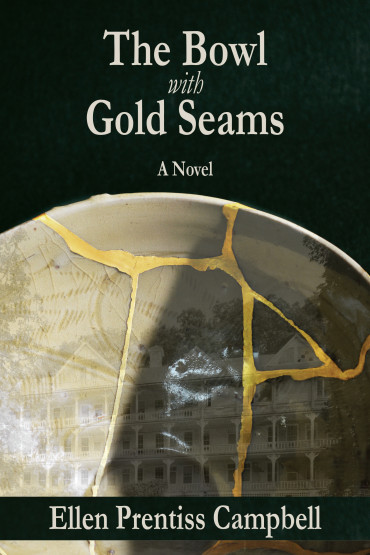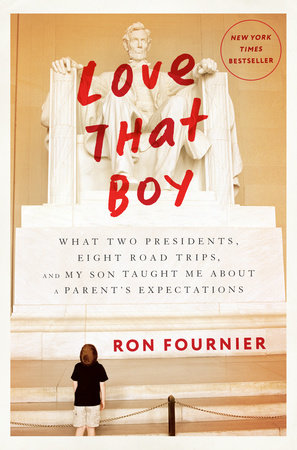The Bowl with Gold Seams reimagines a true, but little-known World War II chapter in the summer of 1945 between VE Day and VJ Day when the Japanese ambassador to Berlin, his staff, and their families were confined in the Bedford Springs Hotel in Pennsylvania which the U.S. had commissioned as an internment center. The novel focuses on Hazel Shaw, an imagined young woman, working at the hotel where the detainees were kept, then examines Shaw’s life years later when she’s the head of a Quaker School facing a moral dilemma. During this later time of turmoil, Hazel attends a conference and meets a woman she’d befriended as a child at the hotel and the two revisit the hotel grounds and learn that beauty and healing can come from things that are broken.
The bowl with gold seams that forms the novel’s title is a black pottery bowl that had been broken and mended with the shards held together with golden glue.
“The bowl’s design of blossoms and Japanese characters seemed caught in a net of shining gold seams. The long-ago artisan who fused the fragments with seams of lacquer dusted with powdered gold had transformed breakage into beauty, highlighting the damage as part of the bowl’s history rather than hiding its repair.”
Hazel had long displayed the bowl on her mantel until a visiting parent had exclaimed over it as a glorious specimen of kintsugi. Later, Hazel took the bowl to a gallery and learned that kintsugi had begun as a fifteenth-century accident after a shogun hadn’t been happy with repairs made to a broken Chinese bowl. He’d had a Japanese artisan re-break and repair the bowl with golden glue and the breaks had formed a gleaming pattern that had then developed into a new art form. Hazel had also found out that her bowl was extraordinarily valuable. Thus, debut author Campbell uses the bowl as a symbol to show that beauty and value can come out of brokenness. Hazel’s brokenness begins with the death of her father and the subsequent loss of her husband Neal whom she’d met in first grade and married just after high school before he shipped out for the war only to be declared Missing in Action a few months later.
In the summer of 1945, Hazel’s typing speed and shorthand got her the job of personal secretary to the State Department’s man in charge of the hotel camp. There she met the Harada family. Takeo Harada was a special attaché and was accompanied by his British wife Gwendolyn and their thirteen-year-old daughter Charlotte. Hazel began lending the internees books and Charlotte became the first of what Hazel considered her surrogate children thus starting her habit of sometimes caring too much about certain students and faculty.
This insightful novel offers a beautiful story of how the way we see things can change. Its themes of fatherly love, confused loyalties, justice, vulnerability, and looking inward to take what’s broken and make it beautiful make this a novel that book clubs will want to discuss.
I’m tempted to tell more of this moving story, but I want to allow the reader to experience its psychological impact without interference. This is a powerful, yet often tender story that reflects Hazel’s kind, Quaker upbringing. That it shows wartime and loss with such gentleness and precision is a tribute to the author’s finely honed skills as a critically acclaimed short story writer and to her experience as a practicing psychotherapist.
Stephanie Kallos’s 2004 debut novel, Broken for You, a novel in which healing comes out of making glorious mosaics from pieces of broken Dresden china, has long been one of my favorite novels. The Bowl with Gold Seams offers similar themes, multi-dimensional characters, and psychological insights that offer the reader the same promise of a compelling story that they will long ponder.
Summing It Up: Read The Bowl with Gold Seams to learn of a precisely described chapter in World War II history that’s been forgotten. Savor the language, characters, and metaphors that make this a vivid debut novel that’s also a page-turner and one you’ll want your book club to discuss. It also contains a reading group guide to make that discussion easier.
Note: The Bedford Springs Hotel, which was closed for thirty years, has recently been restored and reopened so readers can visit it and view its history.
Rating: 5 stars
Category: Fiction, Five Stars, Grandma’s Pot Roast, Pigeon Pie, Super Nutrition, Book Club
Publication date: May 1, 2016
Author Website: http://ellencampbell.net/
Book Trailer: https://www.youtube.com/watch?v=7kyKIYNj_W8 Watch this to see the Bedford Springs Hotel and learn more of the history portrayed in the novel.
What Others are Saying:
Foreword Reviews: https://www.forewordreviews.com/reviews/the-bowl-with-gold-seams/
Washington Independent Review of Books (Warning: this review contains spoilers.): http://www.washingtonindependentreviewofbooks.com/bookreview/the-bowl-with-gold-seams
In Ellen Prentiss Campbell's psychologically astute, highly original novel, cracks in a bowl are repaired with gold, and the resulting network of shimmering lines makes it lovelier than ever. The bowl figures in a fascinating, historically based story: as Japan loses the second World War, captured Japanese diplomats are confined in a Pennsylvania hotel that is staffed by local young people. Years later, the head of a school in trouble, meets up by chance with the child she befriended in the last months of the war and experiences again the beauty of what is broken."
--Alice Mattison, author of When We Argued All Night
"With a sharp eye for detail and accuracy, Ellen Prentiss Campbell recreates a little-known true moment between the Allied victories in World War II--VE Day and VJ Day--when a small resort hotel in the gentle hills of Pennsylvania housed detained Japanese diplomats, and their families and staff, who had been working in Germany. The complexities of wartime loss and bitterness on the home front--and of human compassion--come to fore when one young woman's life is intensely entwined in this single summer's experience, and when the memories cascade with poignant force decades later. This unusual story surprised and moved me, especially in its tender portrayals of father and daughter, and of difficult loyalties in friendship and love--loyalties that would, as Prentiss Campbell writes, come to make what we assume about ourselves and 'our small world...disappear like morning mist burning off the river.'"
"With a sharp eye for detail and accuracy, Ellen Prentiss Campbell recreates a little-known true moment between the Allied victories in World War II--VE Day and VJ Day--when a small resort hotel in the gentle hills of Pennsylvania housed detained Japanese diplomats, and their families and staff, who had been working in Germany. The complexities of wartime loss and bitterness on the home front--and of human compassion--come to fore when one young woman's life is intensely entwined in this single summer's experience, and when the memories cascade with poignant force decades later. This unusual story surprised and moved me, especially in its tender portrayals of father and daughter, and of difficult loyalties in friendship and love--loyalties that would, as Prentiss Campbell writes, come to make what we assume about ourselves and 'our small world...disappear like morning mist burning off the river.'"
--Eugenia Kim, author of The Calligrapher's Daughter






